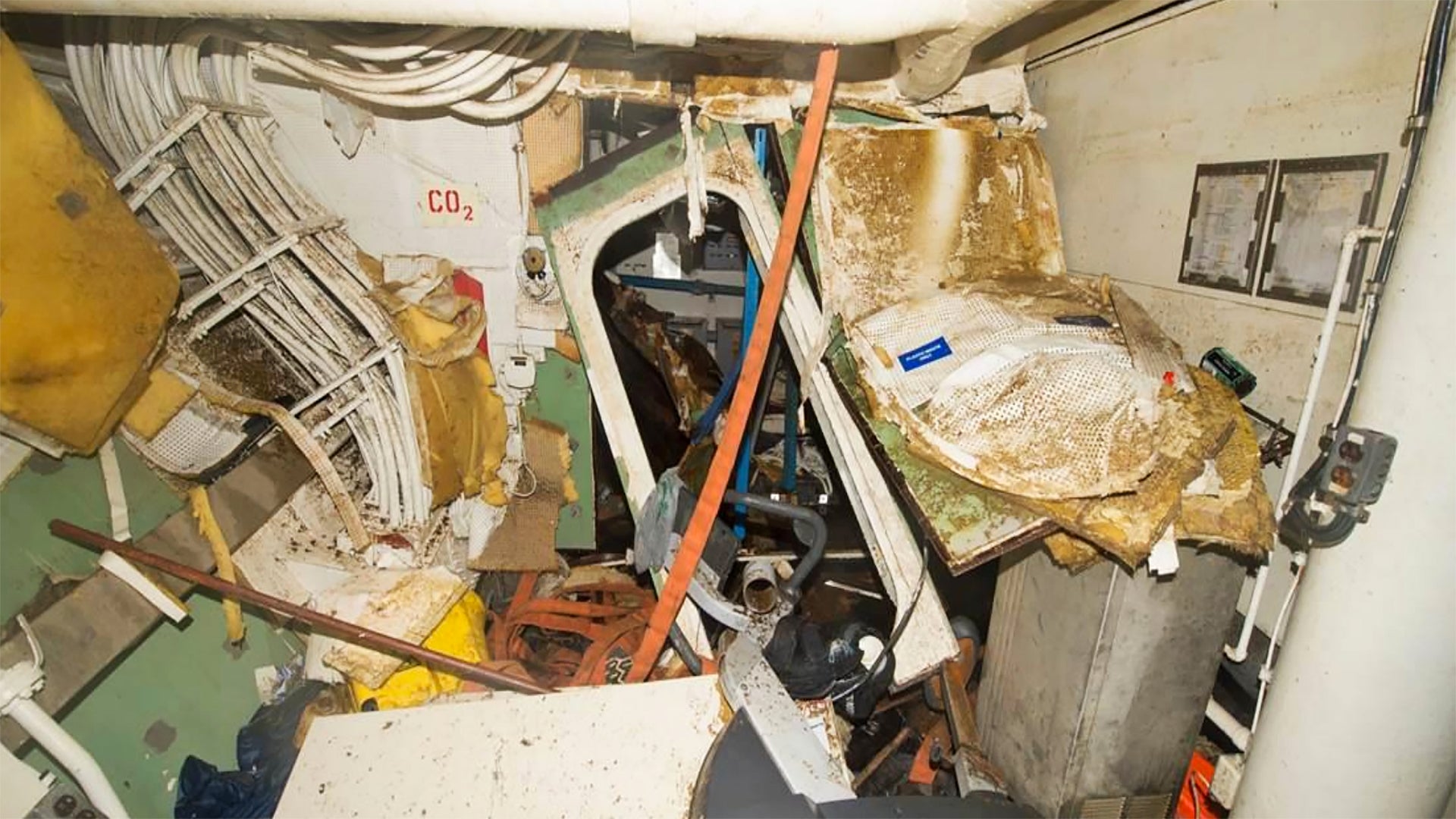As multiple investigations into the USS Fitzgerald’s collision with the freighter ACX Crystal last June grind on, more heads are beginning to roll, including those of the destroyer’s top leadership.
Deputy Chief of Naval Operations Admiral Bill Moran told reporters that the Fitzgerald’s CO, XO and Master Chief Petty Officer would be relieved because the Navy had “lost trust and confidence in their ability to lead.” This is a strong indication that negligence on the crew of the Fizgerald’s behalf likely was the leading factor in the tragic collision that resulted in seven dead sailors, multiple wounded, and one badly damaged Arleigh Burke class destroyer. Admiral Moran went on to add that roughly a dozen of the Fitzgerald’s crew will be removed from duty.
This announcement coincides with the release of documents detailing a preliminary inquiry into what occurred following the collision, which you can read for yourself here. The report gives us the most complete account of the incident as of yet and it offers images of the ship’s badly damaged interior spaces (see below), some of which sailors had to escape from as water was rapidly rushing in. After reading this report one thing is certain, there were some real heroes in those flooding and badly damaged spaces that night.
The cover letter summary of the report from Rear Admiral C.F. Williams, Commander Carrier Strike Group Five, states in part:
“My review of the additional findings confirmed my original determination that the injuries to the three surviving service members, and the deaths of seven Sailors, occurred in the line of duty and not due to misconduct… The Sailors assigned to Berthing 2 should be commended for their response to the dangerous and deadly threat they faced. They did what is expected of Sailors in such a situation: they
checked racks to ensure everyone was awake; they formed calm lines to egress the space on the port side, away from the flooding; and they filed out of the Berthing in an orderly fashion, assisting one another to the ladder.
Two Sailors chose to remain at the bottom of the ladder on the port side of the compartment, and then on top of the hatch after they egressesed, in order to help others out of the space even as the water was rising and began flooding into the space around them. The choices made by these two Sailors likely saved the lives of at least two of
their shipmates.
After the collision, FITZGERALD Sailors responded to the myriad damage control scenarios occurring throughout the ship. Flooding, structural damage, and reports of white smoke stressed the damage control organization; at the same time, efforts to restore power, propulsion, steering and navigation continued. The crew of the FITZGERALD fought hard in the dark of night to save their ship. Ultimately, those damage control efforts and restoration processes succeeded in safely bringing FITZGERALD into port under her own power.
Through their swift and, in many cases, heroic actions, members of the FITZGERALD crew saved lives. No damage control efforts, however, would have prevented Berthing 2 from flooding completely within the first two minutes following the collision, or the deadly circumstances in that situation. In spite of the fact that the Berthing was never completely secured, seven Sailors were unable to egress the space.
The loss of seven shipmates is a tragedy beyond words and a reminder of the dangers inherent in the mission of every ship and Sailor. My thoughts and prayers are with their families and friends… We continue to care for both the ship and her crew as they begin the rebuilding process. No one could have foreseen the challenges FITZGERALD would face, but the courage and strength shown by her crew, even as they mourn the loss of seven shipmates, underscore the essence of Navy’s core values.”
The report details the minutes following the crash and the incredible things well-trained sailors did to save their fellow shipmates and to save the ship itself. The events concerning Berthing Room 2 are especially harrowing:
“Of the 42 Sailors assigned to Berthing 2, at the time of collision, five were on watch and two were not aboard. Of the 35 remaining Sailors in Berthing 2, 28 escaped the flooding. Seven Sailors perished. Some of the Sailors who survived the flooding in Berthing 2 described a loud noise at the time of impact. Other Berthing 2 Sailors felt an unusual movement of the ship or were thrown from their racks. Still other Berthing 2 Sailors did not realize what had happened and remained in their racks. Some of them remained asleep. Some Sailors reported hearing alarms after the collision, while others remember hearing nothing at all.
23. Seconds after impact, Sailors in Berthing 2 started yelling “water on deck!” and “get out!” One Sailor saw another knocked out of his rack by water. Others began waking up shipmates who had slept through the initial impact. At least one Sailor had to be pulled from his rack and into the water before he woke up.
Senior Sailors checked for others that might still be in their racks. The occupants of Berthing 2 described a rapidly flooding space, estimating later that the space was nearly flooded within a span of 30 to 60 seconds. By the time the third Sailor to leave arrived at the ladder, the water was already waist deep. Debris, including mattresses, furniture, an exercise bicycle, and wall lockers, floated into the aisles between racks in Berthing 2, impeding Sailors’ ability to get down from their racks and their ability to exit the space.
The ship’s 5 to 7 degree list to starboard increased the difficulty for Sailors crossing the space from the starboard side to the port side. Many of the Sailors recall that the battle lanterns were illuminated. Battle lanterns turn on when power to an electrical circuit is out or when turned on manually.
Sailors recall that after the initial shock, occupants lined up in a relatively calm and orderly manner to climb the port side ladder and exit through the port side watertight scuttle… They moved along the blue floor and turned left at the end to access the ladder. Even though the Sailors were up to their necks in water by that point, they moved forward slowly and assisted each other. One Sailor reported that FC1 Rehm pushed him out from under a falling locker. Two of the Sailors who already escaped from the main part of Berthing 2 stayed at the bottom of the ladder well in order to help their shipmates out of the berthing area. The door to the Berthing 2 head (bathrooms and showers) was open and the flooding water dragged at least one person into this area. Exiting from the head during this flood of water was difficult and required climbing over debris.
As the last group of Sailors to escape through the port side watertight scuttle arrived at the bottom of the ladder, the water was up to their necks. The two Sailors who had been helping people from the bottom of the ladder were eventually forced to climb the ladder as water reached the very top of the Berthing 2 compartment. They continued to assist their shipmates as they climbed, but were eventually forced by the rising water to leave Berthing 2 through the watertight scuttle themselves.
Before climbing the ladder, they looked through the water and did not see any other Sailors. Once through the watertight scuttle and completely out of the Berthing 2 space (on the landing outside Berthing 1) they continued to search, reaching into the dark water to try to find anyone they could. From the top of the ladder, these two Sailors were able to pull two other Sailors from the flooded compartment.
Both of the rescued Sailors were completely underwater when they were pulled to safety. The last Sailor to be pulled from Berthing 2 was in the bathroom at the time of the collision and a flood of water knocked him to the deck. Lockers were floating past him and he scrambled across them towards the main berthing area. At one point he was pinned between the lockers and the ceiling of Berthing 2, but was able to reach for a pipe in the ceiling to pull himself free. He made his way to the only light he could see, which was coming from the port side watertight scuttle. He was swimming towards the watertight scuttle when he was pulled from the water, red-faced and with bloodshot eyes. He reported that when taking his final breath before being saved, he was already submerged and breathed in water.”
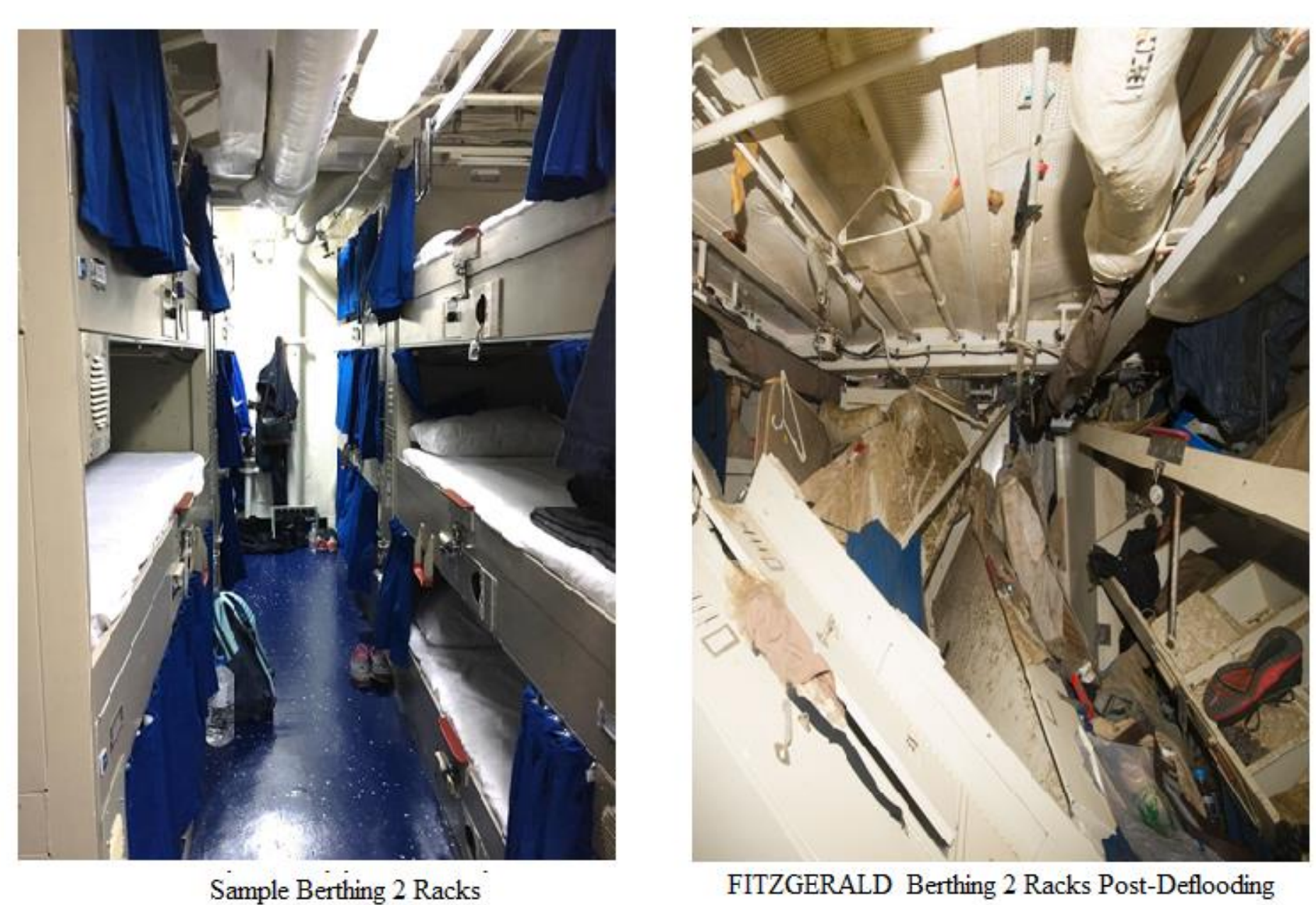
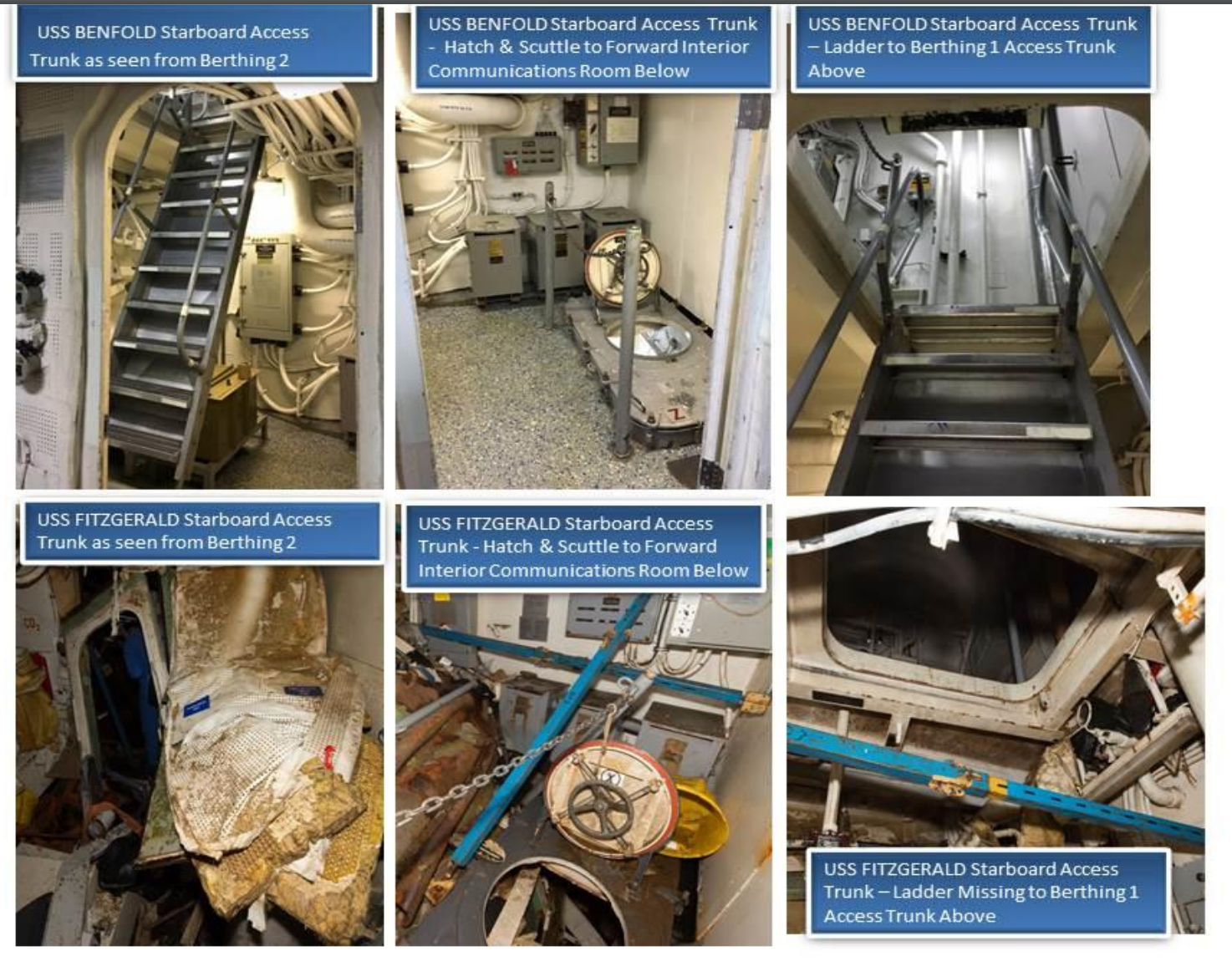
How the Captain was rescued was quite amazing as well, with the report reading:
“The CO was in his cabin at the time of the collision. The CRYSTAL’s bow directly struck his cabin, located above the waterline. The impact severely damaged his cabin, trapping him inside. The CO called the bridge requesting assistance.
Five Sailors used a sledgehammer, kettlebell, and their bodies to break through the door into the CO’s cabin, remove the hinges, and then pry the door open enough to squeeze through. Even after the door was open, there was a large amount of debris and furniture against the door, preventing anyone from entering or exiting easily.
A junior officer and two chief petty officers removed debris from in front of the door and crawled into the cabin. The skin of the ship and outer bulkhead were gone and the night sky could be seen through the hanging wires and ripped steel. The rescue team tied themselves together with a belt in order to create a makeshift harness as they retrieved the CO, who was hanging from the side of the ship.
The team took the CO to the bridge, where a medical team assessed his condition. As he was being monitored by personnel on the bridge, his condition worsened. A team of stretcher bearers moved the CO from the bridge to the at-sea cabin at 0319, and shortly thereafter, due to the severity of his injuries, he was medically evacuated from the ship at 0710 to USNHY via helicopter. He was treated and released on 18 June 2017.”
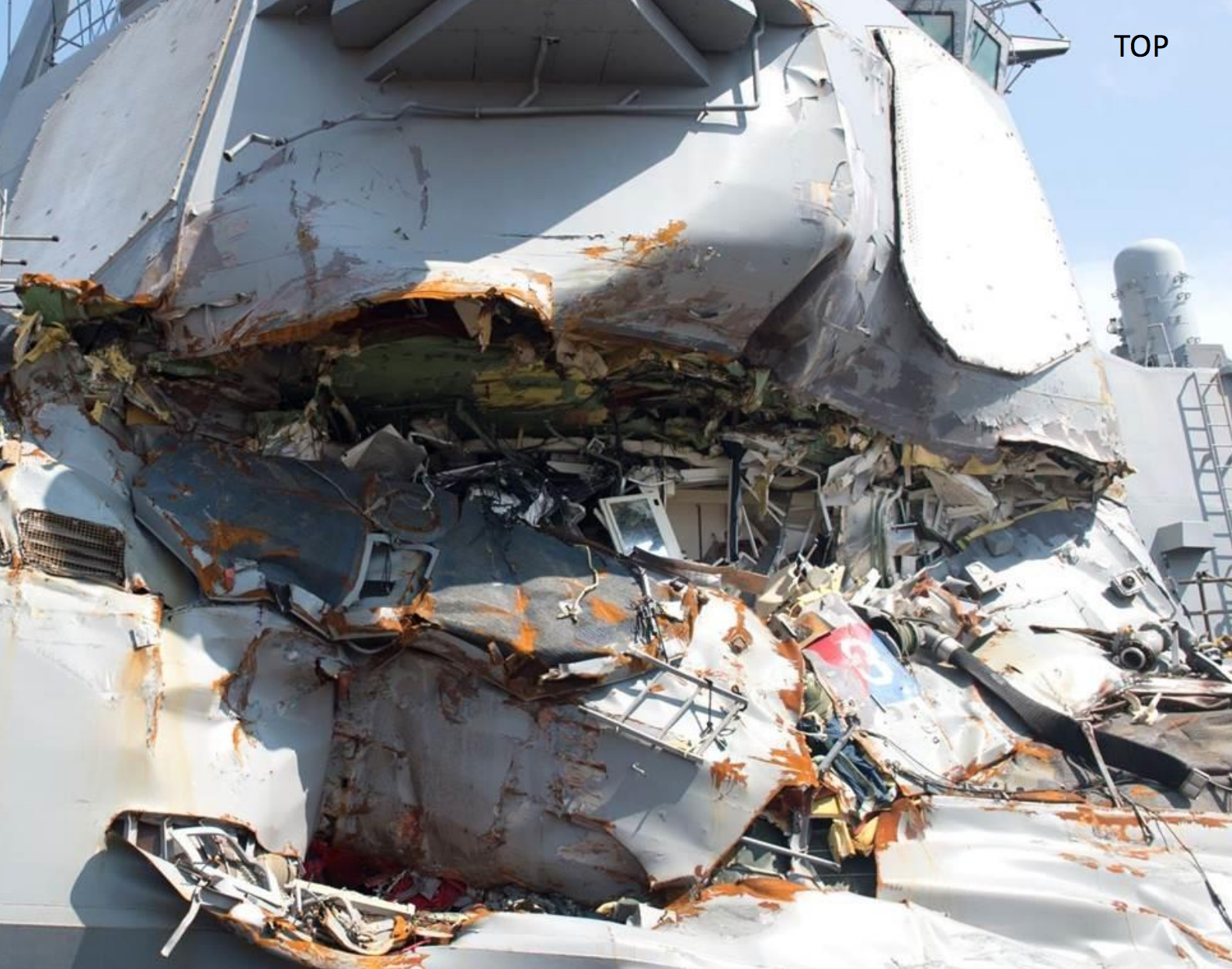
The report goes on to detail damage control effort and the ship’s voyage back to port, along with in-port recovery efforts. It doesn’t talk to the cause of the crash or the events leading up to it, but a few details are mentioned that may be of interest.
Here is the official geometry of the crash:
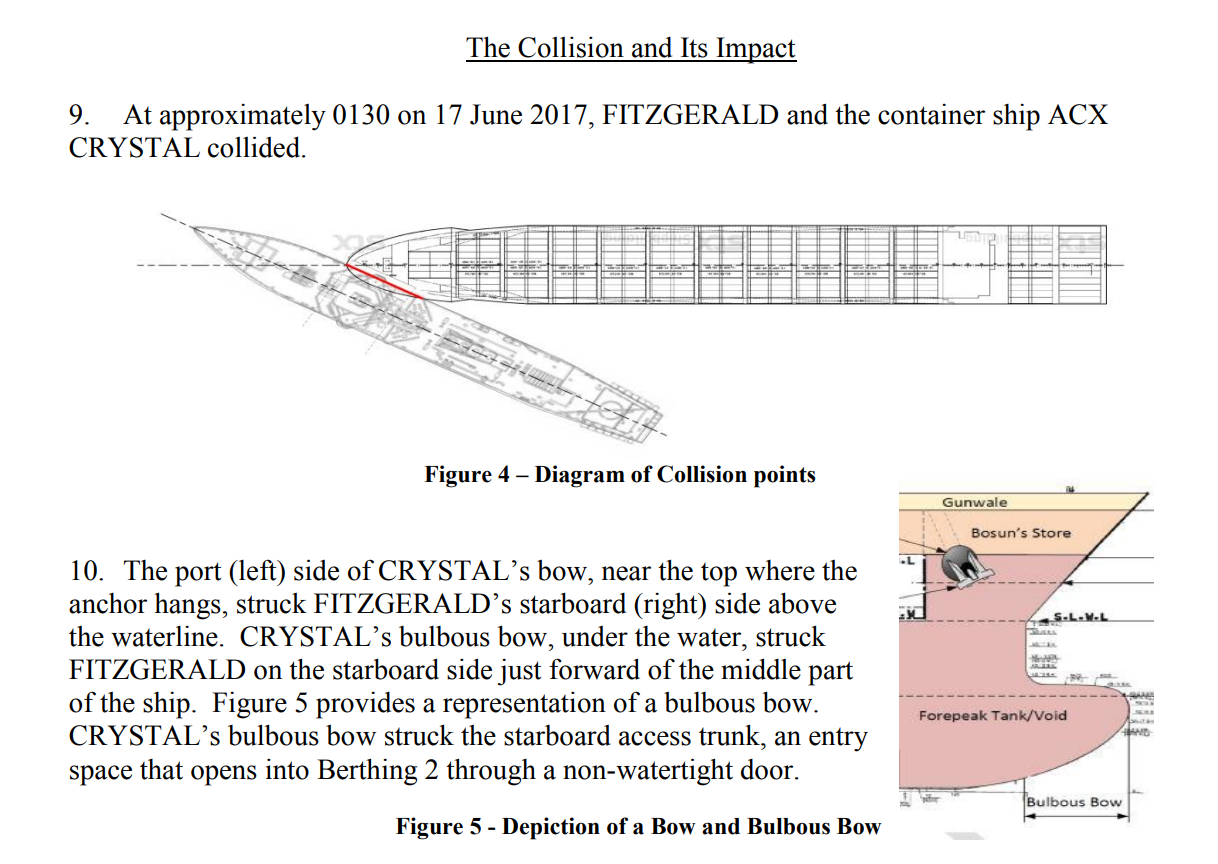
The report also states the following details about the ship’s condition before and following the impact:
“The seas were relatively calm at 2 to4 feet. The sky was dark, the moon was relatively bright, and there was scattered cloud cover and unrestricted visibility. FITZGERALD was operating in a standard condition for deployed ships steaming at night, including being at “darkened ship,” meaning that all exterior lighting was off except for the navigation lights, and all interior lighting was switched to red instead of white light. The damage control posture of the ship was “Modified ZEBRA,”meaning that all doors inside the ship, and all hatches (openings located on the floor between decks) at the main deck and below were shut in order to help secure the boundaries between different areas of the ship in case of flooding or fire.
Watertight scuttles on the hatches (smaller openings that can be opened or closed independently of the hatch) were left open in order to allow easy transit between spaces. These conditions were the normal state of the ship at that hour as required by international navigation rules of the road, and by procedures established for all U.S. Navy surface ships.
The impact at the moment of collision caused FITZGERALD to list (tilt) a reported 14 degrees to port. FITZGERALD then settled into a 7 degree starboard list as the sea flooded into Berthing 2 through the starboard access trunk and weighted the ship deeper into the water on the starboard side. The collision resulted in a loss of external communications and a loss of power in the forward portion of the ship.
Following the collision, FITZGERALD changed her lighting configuration at the mast to one red light over another red light, known as “red over red,” the international lighting scheme that indicates a ship that is “not under command.” Under international navigation rules of the road, this signifies that, due to an exceptional circumstance such as loss of propulsion or steering, a vessel is unable to maneuver as required.”
The report includes a timetable of events, and as you can see, no crash alarm was sounded until after the impact:
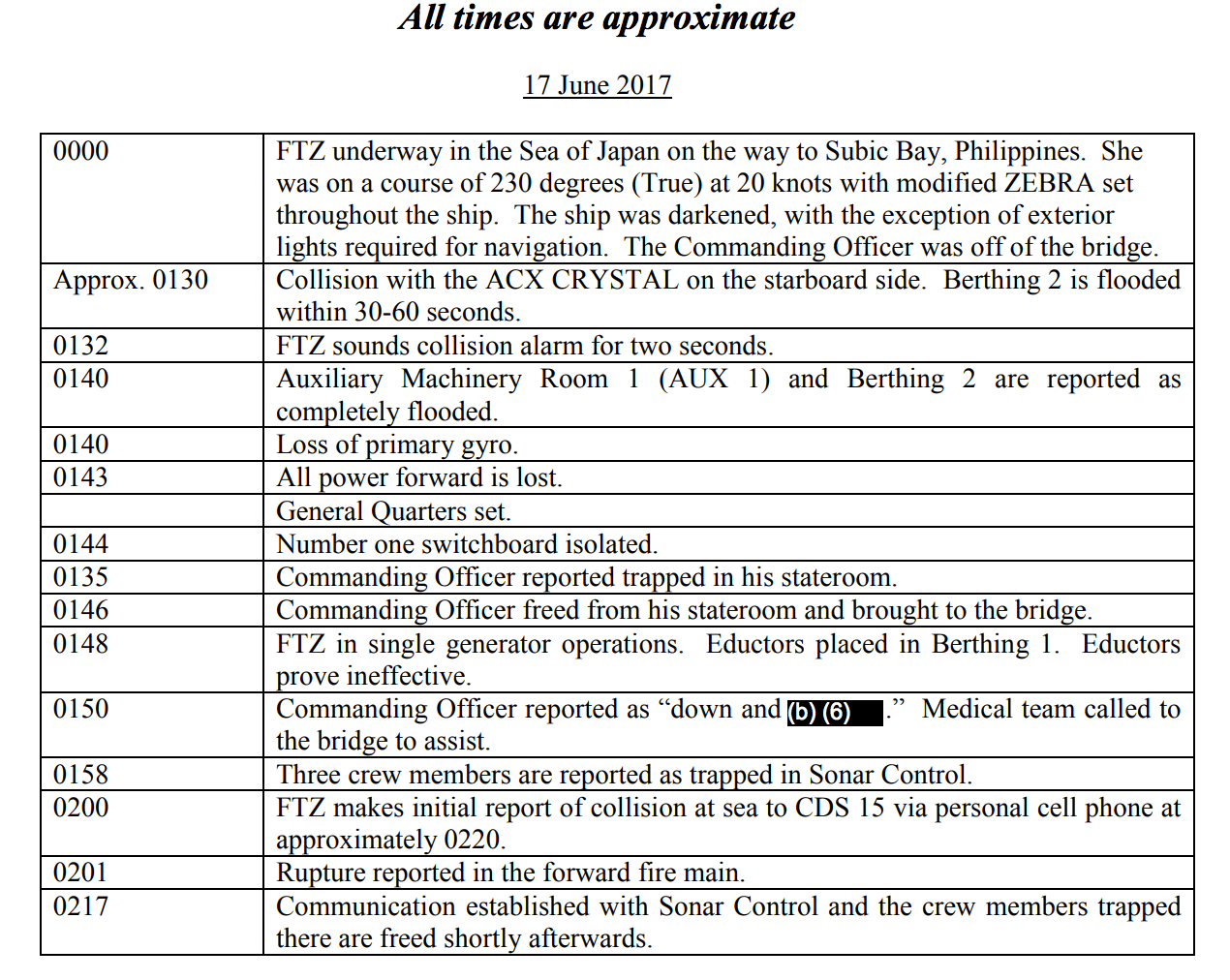
Here is a diagram of the external damage to the ship:
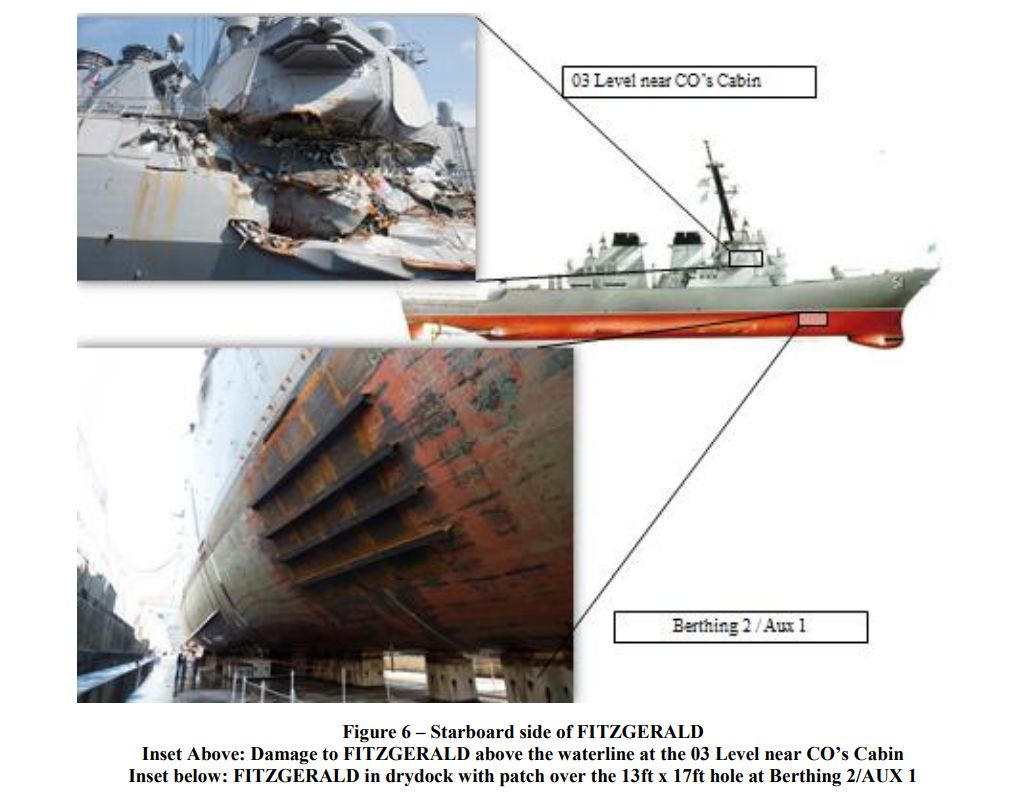
The Navy describes the damage as such:
“The impact of CRYSTAL’s bulbous bow below the waterline punctured the side of FITZGERALD, creating a hole measuring approximately 13ft by 17ft, spanning the second and third decks below the main deck. The hole allowed water to flow directly into Auxiliary Machinery Room 1 (AUX 1) and the Berthing 2 starboard access trunk. The force of impact from CRYSTAL’s bulbous bow and resulting flood of water pushed the non-water tight door between the starboard access trunk and Berthing 2 inward. The wall supporting this door pulled away from the ceiling and bent to a near-90 degree angle. As a result, nothing separatedBerthing 2 from the onrushing sea, allowing a great volume of water to enter Berthing 2 very quickly.”
We’ll have to wait for the final investigative finding on the crash itself to get the prologue to the story of what caused this tragic accident, but at least now we have a more complete picture of what occurred following the impact, including some displays of incredible bravery by US Navy sailors.
Contact the author: Tyler@thedrive.com
